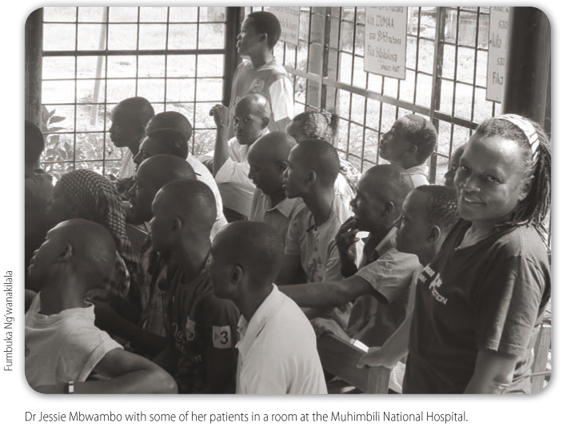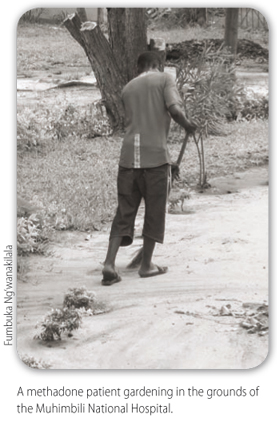NEWS
New treatment gives hope to East Africa's drug users
The United Republic of Tanzania is the first mainland sub-Saharan country to launch a national methadone programme as part of its battle to fight the twin epidemics of heroin addiction and HIV infection. Fumbuka Ng'wanakilala reports.
It was the smell of heroin that lured her. The mother of three, who lives in a poor neighbourhood in the Tanzanian commercial capital, Dar es Salaam, was selling the highly addictive drug for a dealer boyfriend. "I started craving the smell of the heroin and slowly began using it," says the woman, who asked to be referred to as "Hope." Aware of the dangers of HIV transmission through needle sharing, she bought syringes from pharmacies and hid them away for her personal use, but friends found them. "They would use these syringes and carefully put them back where I hid them," she says. "That's how I ended up getting infected [with HIV]."
Desperate to get off the drug that was wrecking her life, the only treatment available to Hope through the country's health system was abrupt cessation supervised in a public or private hospital. She paid 70 000 Tanzanian shillings (US$ 44) for a brutal period of withdrawal symptoms that were so unbearable she went back to injecting heroin a week later. Then in 2011, community outreach workers in her neighbourhood started talking about a new clinic in the country's biggest referral hospital, Muhimbili National Hospital in Dar es Salaam.
The clinic was part of a new methadone programme, the first such national programme in mainland sub-Saharan Africa to treat heroin addiction. The island state of Mauritius launched such a national programme in 2006.
Unlike the abstinence approach, the Tanzanian programme provides patients with methadone maintenance treatment and other care they may need, as part of a comprehensive package of services for people who inject drugs. Methadone is a medicine that is not injected but taken in syrup form, thus removing the risks of injecting an illicit drug of unknown and probably dubious quality with dirty needles. It works by blocking the effects of other opioids, thus stopping any craving for them.
Dr Jessie Mbwambo was instrumental in making methadone available at Muhimbili National Hospital, where she works as a senior specialist psychiatrist. She says that the methadone programme grew out of work undertaken by the Department of Psychiatry and Mental Health based there, notably by Professor Gad Kilonzo, and that it draws on the expertise of Douglas Bruce, an assistant professor of medicine in the Infectious Disease Section of the Yale University School of Medicine and the lead harm reduction consultant for the Pangaea Global AIDS Foundation.

The Tanzanian programme, which is funded by the US President's Emergency Plan for AIDS Relief, is a response to the country's growing epidemic of people who inject drugs, mainly heroin, that has been feeding into the country's HIV epidemic. "Prior to a five-zone rapid situational assessment study conducted in the early 2000s, there was a general assumption that injection drug use was not a significant problem in our country and that this was something foreigners did," says Mbwambo.

The study changed those widely held perceptions, while a sense of what the epidemic might do for HIV prevalence was sharpened by reports of hair-raising practices such as "flash-blood," where one user injects heroin and then draws a syringe full of his or her own blood to give to a second user, who cannot afford a heroin fix.
There are still no official estimates on the number of people who inject drugs in the east African country of some 45 million people, but a ball park figure of between 25 000 and 40 000 is frequently cited. According to Mbwambo, conservatively, there are around 15 000 people who inject drugs living in Dar es Salaam alone; most of them are using heroin.
Large quantities of heroin started arriving on the eastern coast of Africa in the late 1990s, when smugglers switched from their traditional overland routes from Asia to the sea route across the Indian Ocean. According to the United Nations Office on Drugs and Crime, East Africa is "attractive to international drug trafficking syndicates as they are quick to exploit non-existent or ineffective border (land, sea and air) controls, limited cross border and regional cooperation as well as serious deficiencies in the criminal justice systems."
People who inject illicit drugs are at high-risk of becoming infected with HIV and of infecting others. Current estimates for the United Republic of Tanzania put HIV prevalence in the general population at 5.6% but, according to Mbwambo, studies show that 42% of people who inject drugs in Dar es Salaam are HIV positive. "One study of residual blood from syringes used for drug injection found that 57.4% of the syringes tested positive for HIV," she says, noting that the high prevalence of HIV among drug users has, in turn, serious implications for the population as a whole.
One local nongovernmental organization, called Youth Volunteers Against Risky Behaviours, has taken up the challenge. Working from a small office in Kinondoni, a poor suburb that is home to many drug users, community outreach workers go to the places where drug users gather, providing them with clean needles and syringes, and kits to clean their injecting equipment.
They also tell injecting drug users about free treatment for heroin addiction and they refer those who are willing and eligible to the methadone treatment clinic at Muhimbili hospital. "The vast majority of drug users have strained relationships with their families and community as a result of their drug use," says Salama Kibao, one of 13 social workers based in the district who supports drug users and their families by providing counselling to those in need. "We continue to work with them once they are on the methadone programme to help them rebuild their shattered lives."

The Muhimbili was chosen as the first site for the national methadone programme because it had the best staff, laboratory and pharmaceutical skill-base, but it still had to be upgraded to serve the purpose, and that upgrade included building a pharmacy that is secure against thieves.
The initial target for the facility was to treat about 175 patients but, in the end, three times that number enrolled and, by November 2012, there were more than 600 people receiving treatment. Patients are between 16 to 52 years old and most come from poor backgrounds. A second methadone treatment facility opened at the Mwananyamala hospital in Dar es Salaam in September last year, and expects to enrol up to 1200 patients. Going forward, the aim is to open three further treatment facilities in the area by the end of 2013.
Employing two nurses, two social workers, eight doctors, and four pharmacists, the Muhimbili facility provides methadone to patients on a daily basis and, at the same time, their daily medication for other health problems such as HIV, tuberculosis, injuries and dental conditions. The doses are observed by staff, following World Health Organization (WHO) and other international standards. For their part, patients have to commit to a treatment plan, which includes abstinence from alcohol and illicit drug use.
"This integrated model of treatment is what we recommend in all parts of the world facing combined epidemics of opioid dependence, HIV and tuberculosis," says Dr Nicolas Clark, a medical officer in the Management of Substance Abuse unit at WHO in Geneva. "The success rate of this treatment approach is very high." Clark argues that the approach holds huge untapped potential: "HIV in opioid users is entirely preventable and treatable yet, globally, only an estimated 5% of opioid users who need HIV treatment are receiving it."
It is too early to say whether the programme has actually reduced or prevented HIV infection among the 15 000 people who inject drugs in Dar es Salaam. Mbwambo says that at least two years of data would be needed to gauge this. However, her patients' overall health condition has significantly improved and, she says, they have reduced their intake of other drugs and of alcohol. As a result, some patients have returned to work or college or enrolled in adult education classes. Others have found work painting the clinic buildings and gardening in the hospital grounds.
Challenges remain of course, including the to-be-expected difficulty patients have in sticking to the treatment agreement plan. Patients struggle to find housing, jobs and to get an education or stay in school or college, let alone to cover the daily transport costs to get to the clinic and home again, given that many of them live below the poverty line.

The Tanzanian response to the dual epidemic has only just started. "We need government information campaigns warning people about the dangers of illicit drugs," says Mbwambo.
Mbwambo is particularly concerned that fewer than 50 of the 606 patients undergoing methadone treatment at Muhimbili are women. "Women are a hard-to-reach population and this is a concern given their higher rates of HIV infection." HIV prevalence among women who inject drugs is thought to be three times that of men, although the reasons for this are not fully known. "There is a need to consider ways of reaching out more effectively to women in need of methadone services," Mbwambo says.
After more than a year of methadone treatment, Hope feels that she is slowly getting control of her life again, and she has no doubt about the value of the treatment. "Some people say that methadone just causes more addiction. My advice to them is that methadone treatment really helps," she says. Changing the socioeconomic and geopolitical factors that drive the HIVheroin epidemic in the country, may be considerably harder. 
